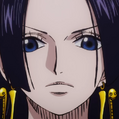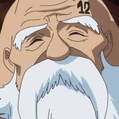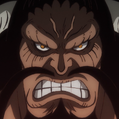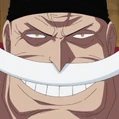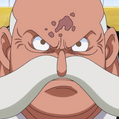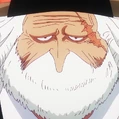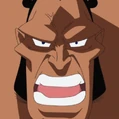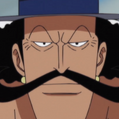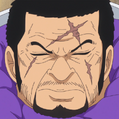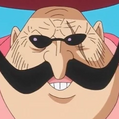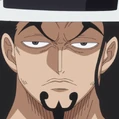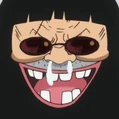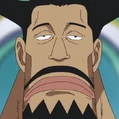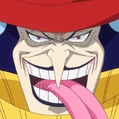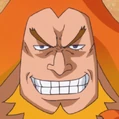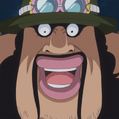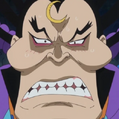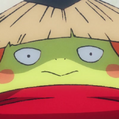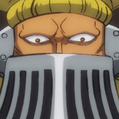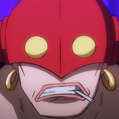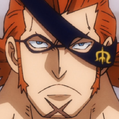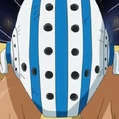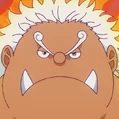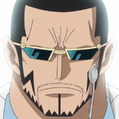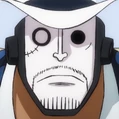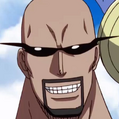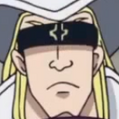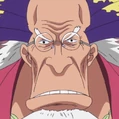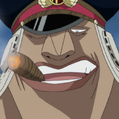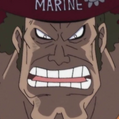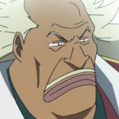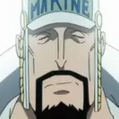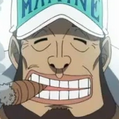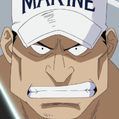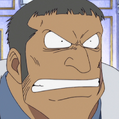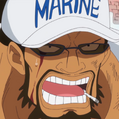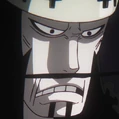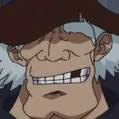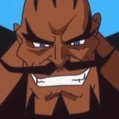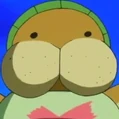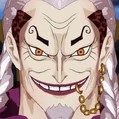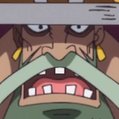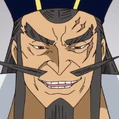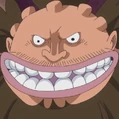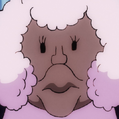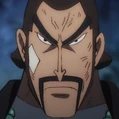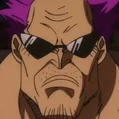
|
Ahoy! This here is the 172nd Featured Article.
"Haki" has been featured, meaning it was chosen as an article of interest.
|
Haki is a mysterious power that allows individuals to harness their own spiritual energy for various superhuman feats. As this energy manifests from willpower, it is theoretically open to all of the world's living creatures; the vast majority, however, are either ignorant of how to unlock it or unable to achieve mastery. Haki users are common in the New World, rare in Paradise, and virtually non-existent in the Four Blues.
Current understandings of Haki define three distinct types, each tied to a different ability: sensing others' spiritual energy to anticipate their movements, producing a protective coating of energy from one's own body, and—for a certain group of "chosen ones"—overwhelming the willpower of others.[2][3]
Haki and its users have underpinned many significant events throughout the series—notably, Shanks used it to drive off the Lord of the Coast and save a young Monkey D. Luffy's life.[1] The term "Haki" was first used much later when Blackbeard was commenting on Luffy's bounty in Jaya,[4] and was hinted at during Shanks' visit with Whitebeard.[5] The underlying concepts of Haki were introduced during the Sabaody Archipelago and Amazon Lily Arcs.[6][7] The concept was clearly explained later on by Rayleigh to Luffy at the start of the latter's training on Rusukaina Island.[3]
Overview[]
| — Silvers Rayleigh explaining Haki to Luffy at the start of his training.[3] |

Rayleigh training Luffy to use Haki.
Haki is dormant in every living person, but most people around the world never even learn about the existence of Haki, let alone how to utilize it. The people who do usually awaken it through proper instruction and intense training. Haki is apparently quite difficult to master, as Rayleigh stated that two years was not enough time to learn the basics,[8] though several characters managed to master it within the span of the two year timeskip, including Luffy, Zoro, Sanji, Tashigi, Smoker, Koby, and Bellamy. In very rare instances, a person can awaken their Haki on their own due to an experience of extreme stress or shock, such was the case with Koby during the Summit War of Marineford,[9] and Ace during his battle against Vice Admiral Draw. Some people (such as Aisa and Otohime) are actually born with awakened Observation Haki, and are able to use it with no known training.[10][11]
A person can also make their Haki become stronger, especially when they push themselves and their Haki to the limit and beyond in battles against far stronger opponents.[12] A person's Haki can even grow stronger before that person actually learns to be a Haki user and even before they find out that Haki exists; for example, Blackbeard noted that Luffy's Haki had grown stronger by the time of the mass breakout in Impel Down compared to their first meeting on Jaya.[13]
It is even possible to maintain and use Haki while unconscious, as seen when Newgate used Observation Haki in his sleep to defend himself from Ace;[14] when Chinjao was defeated, and he still maintained Armament Haki on his head after he fainted;[15] and when Luffy released a burst of Supreme King Haki after being knocked unconscious by Kaidou.[16]

Garp, a powerful ordinary human in his old age, without the need for any Devil Fruit, is capable of destroying an entire city with just one punch imbued with Haki.
According to Kaidou, Haki is the true defining factor that determines whether or not someone can conquer the sea, because only Haki transcends all, unlike Devil Fruit powers, no matter how powerful they may be. A clear and notable example of this rule was Gol D. Roger and Edward Newgate; Newgate was considered the "Strongest Man in the World" and he possessed the power of the Gura Gura no Mi, the Devil Fruit called the "Strongest Paramecia" which granted him the power to generate powerful quakes and shockwaves and could potentially destroy the world.[17] However, even when Newgate was in his prime, he was still matched by Roger, who did not have a Devil Fruit.[18] Roger conquered the Grand Line with the power of Haki alone, achieving a feat that multiple powerful Devil Fruit users, including Newgate, Big Mom, Kaidou, and Shiki, all failed to accomplish, even decades after Roger's death. Further testament to this is that many of the most powerful characters seen in the series possess great mastery of Haki, including among the Seven Warlords of the Sea, Marine Admirals, the Four Emperors, and the Five Elders.

Awakened Zoan users have their transformations reversed by a powerful blast of Haki.
Furthermore, Haki also has the unique capability to reverse/nullify the effects of other people's Devil Fruit powers.[19][20] The most common display of this is through Armament Haki, which is well known for allowing someone to hurt Devil Fruit users, including Logia. In order to accomplish greater feats, the user must possess a very powerful level of Haki. Notably, a burst of Joy Boy's Haki being released was potent enough to force the Five Elders, who are themselves powerful Haki users, out of their Awakened Zoan transformations.[21] This application has only been displayed by individuals whose bounties are well above ![]() 1,000,000,000.[22][23]
1,000,000,000.[22][23]
Despite its great capabilities, the Haki in a person's body is not limitless and it can be depleted from overuse, rendering the user unable to use it for a set period of time while it regenerates.[24][25][26]
Notably, Haki originates from an individual's spirit and not their physical body, so even if a person's mind is transferred into another body, they would still be capable of using their Haki to the same degree that they normally can, even if the body they transferred into is not a Haki user.[27]
Types of Haki[]
Haki is separated into three types, or "colors" (色, shoku?). The three types of Haki are:

Luffy sensing his opponent's next attack with Observation Haki.
- Observation Haki (見聞色の覇気, Kenbunshoku no Haki?), which gives the user a sixth sense of the world around them, allowing them to sense the presence, strength, and emotions of other people, even if they are out of sight or far away. It also grants limited precognitive abilities, allowing the user to sense their opponents' intentions and predict their actions and attacks before they happen.[3]
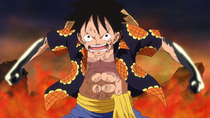
Luffy coating his arms with Armament Haki.
- Armament Haki (武装色の覇気, Busōshoku no Haki?), which allows the user to use their own aura as armor to defend against attacks, as well as make their own attacks more potent.[3] It can also be used to bypass Devil Fruit defenses, such as the intangibility of a Logia. A person can apply the armament to a section of their body, over their entire body, and even imbue it onto their weapons.[30][3] A coating of Armament Haki will cause the coated area to turn a shiny black, and a particularly thick and powerful coating will have a flame-like pattern along its edge.
- An advanced level of Armament Haki allows the user to emit the armament a short distance without a medium.[31]
- A higher grade of advanced Armament Haki allows the user to make the emitted armament flow into a target's body and destroy it from the inside-out.
- An advanced level of Armament Haki allows the user to emit the armament a short distance without a medium.[31]
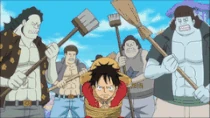
Luffy knocking out enemies with Supreme King Haki.
- Supreme King Haki (覇王色の覇気, Haōshoku no Haki?), which grants the user the ability to unleash their own willpower in order to overpower the will of others.[3] This results in victims being mentally overwhelmed by the user, with particularly weak-willed foes instantly losing consciousness. It can also apply pressure onto objects and damage them, a clash between two particularly strong Supreme King Haki users is capable of "splitting the heavens". Unlike the other types of Haki which can be learned by anyone, Supreme King Haki is a rare ability that only one in several million people are born with the ability to use.
- An advanced level of Supreme King Haki allows the user to infuse their conquering spirit into their weapons and physical attacks, greatly augmenting their power. Only a small handful of the most powerful Supreme King Haki users are able to achieve this.[32]
- Another advanced level of Supreme King Haki allows for the ability to manipulate one's aura or presence, which negates an opponent's ability to sense the user with Observation Haki.[33]
Most people who can use Haki tend to have one type that they are better at, and, as a result, focus on training and fighting with that type primarily. However, a person can improve their abilities with all the types of Haki, it just requires more work.[3]
Each type of Haki has levels of usage, so even two proficient users might not be of equal strength. Furthermore, it is possible to use at least two types of Haki simultaneously.[34]
Haki Users[]
- See also the associated category: Haki Users.
It was mentioned that all Marines with the rank of Vice Admiral and above, are capable of using Haki.[35] So far, the characters who have clearly shown the use of Haki or have been stated to be able to use it are:
All Types | ||||
|---|---|---|---|---|
At Least/Only Supreme King | ||||
At Least/Only Observation | ||||
At Least/Only Armament | ||||
Unknown | ||||
Non Canon Users | ||||
Anime and Manga Differences[]
- In the manga, those hit with Supreme King Haki foam at the mouth after or while losing consciousness, whereas, in the anime, they simply faint.
- In the anime, the use of Supreme King and Armament Haki creates a rippling or shockwave-like effect, similar to the Gura Gura no Mi, while in the manga, it is completely invisible. Also, in recent episodes, the use of Supreme King Haki causes the affected area, excluding the user, to gain a dark blue tint. However, this could just be for dramatic effect. In the One Piece Film: Z, the Supreme King Haki's use creates a circular purple wave. Also, using advanced Armament Haki produces petal-like particles, likely to emphasize it's alternate name of "Ryuo".
- In the anime, some Haki users are shown surrounded by different color auras (such as red for Luffy, purple for Doflamingo or pink for Big Mom) even if they are not using Haki at that moment.
Translation and Dub Issues[]
The term Haki (
- "Ambition" or "Aspiration"
- "Drive" or "Vigor"
- "(Domineering) Spirit"
- "Will (to Conquer/Rule)"
- "Supreme/Hegemonic Spirit/Ki" (kanji transl. individually)
Unlike many of the other terms idiosyncratic to One Piece, "Haki" uses no unorthodox spellings or readings.
As the term "Haki" was given no overt significance when first used by Blackbeard in the Jaya Arc,[4] all early translations—fan or professional—overlooked it, at most framing it as a reference to Luffy's personality. However, its reoccurrences from the Post-Enies Lobby Arc on were almost always in quotation marks, alerting most translators to its significance; around this point, both the VIZ manga and the Funimation anime began leaving "Haki" intact (only adding occasional qualifiers such as "power" or "energy").
Regarding video games: for One Piece: Unlimited Adventure and One Piece: Unlimited Cruise, localized by Namco-Bandai, "Haki" has been translated as "Ambition". However, beginning with One Piece: Pirate Warriors, also localized by Namco-Bandai, it has been left as "Haki".
Among the fanbase, the different types of Haki are commonly known by the abbreviations CoA (Color of Armament), CoO (Color of Observation) and CoC (Color of Conqueror's). However, the term "Color of Conqueror's" has never been used by official translations, which instead opted for "Color of the Supreme King" or "Conqueror's Haki".
Trivia[]
- In principle, Haki is similar to common depictions across modern fantasy fiction—like manga and anime—of the ability to tap into, control, and channel one's vital and/or spiritual energy in combat. Such ability (or rather, the energy manipulated) is often referred to as ki (気) in Japanese, and qì/ch'i (氣/气) in Chinese, being inspired by the so-named concept rooted in Chinese philosophy, folk religion, Taoism, martial arts, and traditional medicine.
- The term "Haki" in particular contains the shinjitai kanji ki (気, simplified from the kyūjitai 氣). The correspondent Chinese term is 霸氣, read as Bàqì ("bah-chee").
- Not only is Haki a Japanese term, "Haki" was also the name of a Scandinavian Sea-King (a name given to powerful pirates) in Norse mythology.
- According to Garp, Haki usage can actually be a hindrance when one is trying to train up one's physical strength. If one just relies on Haki to empower one's punches, for instance, they will not become inherently physically stronger.[36]
- Despite Bartholomew Kuma losing his will due to the Pacifista conversion applied onto him, he is nevertheless able to manifest Haki, which is a manifestation of willpower.[37]
- In the anime, certain animals have shown the capacity to learn how to use Haki (particularly Armament Haki). Specifically, this has been shown twice:
- Alpacacino, a member of the Neo Marines, was shown using Armament Haki to damage Luffy.[38]
- The Kung-Fu Dugong captain of the Sea Animal Pirates, was seen using Haki.[39]
References[]
- ↑ 1.0 1.1 One Piece Manga and Anime — Vol. 1 Chapter 1 (p. 42) and Episode 4, Lord of the Coast flees from Shanks.
- ↑ One Piece Manga and Anime — Vol. 53 Chapter 519 (p. 18) and Episode 413, One of the Kuja tribe members notes Luffy used Supreme King Haki while fighting Sandersonia and Marigold.
- ↑ 3.0 3.1 3.2 3.3 3.4 3.5 3.6 3.7 One Piece Manga and Anime — Vol. 61 Chapter 597 (p. 12-17) and Episode 516, Rayleigh explains Haki.
- ↑ 4.0 4.1 One Piece Manga and Anime — Vol. 25 Chapter 234 (p. 17-19) and Episode 151, Blackbeard is surprised at Luffy's bounty.
- ↑ One Piece Manga and Anime — Vol. 45 Chapter 434 (p. 4-5) and Episode 316, Shanks knocks out various members of the Whitebeard Pirates.
- ↑ One Piece Manga and Anime — Vol. 52 Chapter 503 (p. 18-19) and Episode 397, Silvers Rayleigh knocks out a large group of people in the Human Auction House.
- ↑ One Piece Manga and Anime — Vol. 53 Chapter 516 (p. 7) and Episode 410, Marguerite explains the power behind the Kuja warriors' arrows as "Haki".
- ↑ One Piece Manga and Anime — Vol. 61 Chapter 597 (p. 18) and Episode 516, Rayleigh states how hard it is to master Haki.
- ↑ One Piece Manga and Anime — Vol. 59 Chapter 579 (p. 7) and Episode 488, Koby is hearing the voices of the dying people
- ↑ One Piece Manga and Anime — Vol. 29 Chapter 265 (p. 3) and Episode 174, Aisa reveals she was born with Mantra, a name given to Observation Haki.
- ↑ One Piece Manga and Anime — Vol. 63 Chapter 621 (p. 10) and Episode 540, Otohime is revealed by Minister of the Right to have Observation Haki from birth.
- ↑ One Piece Manga and Anime — Vol. 88 Chapter 886 (p. 19) and Episode 860, Luffy recalls Rayleigh telling him how Haki increases
- ↑ One Piece Manga and Anime — Vol. 56 Chapter 544 (p. 8) and Episode 447, Blackbeard comments about Luffy's Haki.
- ↑ One Piece Manga and Anime — Vol. 57 Chapter 552 (p. 11) and Episode 461, Whitebeard uses Observation Haki while sleeping.
- ↑ One Piece Manga and Anime — Vol. 72 Chapter 719 (p. 17) and Episode 649, Chinjao uses Armament Haki unconsciously.
- ↑ One Piece Manga and Anime — Vol. 92 Chapter 924 (p. 5) and Episode 916, Luffy uses Supreme King Haki against some Beasts Pirates unconsciously.
- ↑ One Piece Manga and Anime — Vol. 57 Chapter 552 (p. 18) and Episode 462, Sengoku claims Whitebeard has the power to destroy the world.
- ↑ One Piece Manga and Anime — Vol. 104 Chapter 1047 (p. 8-9) and Episode 1074.
- ↑ One Piece Manga and Anime — Vol. 67 Chapter 661 (p. 19) and Episode 586, Smoker warns Tashigi against fighting Law because her Haki is too weak to counter his Devil Fruit power.
- ↑ One Piece Manga and Anime — Vol. 69 Chapter 690 (p. 15-17) and Episode 616, Doflamingo boasts about the strength of Vergo's Haki, although Law proves him wrong.
- ↑ One Piece Manga — Chapter 1122 (p. 12-13), The Elders are forced out of their transformations.
- ↑ One Piece Manga and Anime — Vol. 100 Chapter 1009 (p. 7) and Episode 1025, Law tells Kid that he cannot move Kaido or Big Mom due to their powerful Haki.
- ↑ One Piece Manga and Anime — Vol. 105 Chapter 1063 (p. 11) and Episode 1093, Law demonstrates that he can nullify Devil Fruit effects with his Haki, but remarking it has to be powerful enough.
- ↑ One Piece Manga and Anime — Vol. 78 Chapter 785 (p. 3) and Episode 727, Law notes that Luffy's Gear Fourth technique is overusing his Haki.
- ↑ One Piece Manga and Anime — Vol. 79 Chapter 786 (p. 7) and Episode 728, Luffy lost his Haki after using Boundman and had to wait ten minutes for it to regenerate.
- ↑ One Piece Manga and Anime — Vol. 88 Chapter 886 (p. 18) and Episode 860, Luffy mentions that Katakuri's Observation Haki can be depleted if their fight drags out long enough.
- ↑ One Piece Manga and Anime — Vol. 68 Chapter 672 (p. 10) and Episode 598, Sanji is capable of using Haki in Nami's body despite the latter being unable to use it.
- ↑ One Piece Manga and Anime — Vol. 86 Chapter 860 (p. 14) and Episode 830, Bege comment about Katakuri's ability.
- ↑ One Piece Manga and Anime — Vol. 93 Chapter 939 (p. 11-13) and Episode 935.
- ↑ One Piece Manga and Anime — Vol. 78 Chapter 779 (p. 3) and Episode 720, Zoro remembers his training with Mihawk.
- ↑ One Piece Manga and Anime — Vol. 93 Chapter 937 (p. 4) and Episode 933, Luffy thinks about Rayleigh's level of Haki.
- ↑ One Piece Manga and Anime — Vol. 100 Chapter 1010 (p. 12-17) and Episode 1028, An advanced application of Supreme King Haki is used by Luffy to attack Kaidou.
- ↑ Volume 4000000000 "RED".
- ↑ One Piece Manga and Anime — Vol. 72 Chapter 716 (p. 16-19) and Episode 646, Luffy and Don Chinjao use both Armament and Supreme King Haki simultaneously.
- ↑ One Piece Manga and Anime — Vol. 60 Chapter 594 (p. 7) and Episode 511, Dr. Fishbonen states Haki is a power all vice admirals use.
- ↑ One Piece Manga and Anime — Vol. 107 Chapter 1087 (p. 11) and Episode 1121.
- ↑ One Piece Manga — Vol. 109 Chapter 1103 (p. 17), Kuma hardens his fist with Haki.
- ↑ One Piece Anime — Episode 578, Alpacacino fires a Haki-imbued cannon ball.
- ↑ One Piece Anime — Episode 626, Haki being used by a Kung-Fu Dugong.
External links[]
- Spirit – Wikipedia article on the concept of the "spirit" as a vital principle and/or animating force within humans (or all living things), as described in different world philosophies and religions.
- Vitalism – Wikipedia article on the doctrine that life involves some immaterial "vital force" to distinguish organisms from non-living entities.
- Energy – Wikipedia article on the concept of "energy" (as inherent to living entities, distinct from the scientific concept) in fields of esotericism, spiritualism, alternative medicine, etc.
- Qi – Wikipedia article on the concept of life-force (also romanized as "ch'i" or "chi") in traditional Sinospheric culture(s), philosophy, medicine, etc.
- Aura – Wikipedia article on the paranormal/pseudoscientific concept of "aura" (e.g., in alt. spiritual medicine): as an invisible energy field surrounding living beings.
- Will(power) – Wikipedia article on the philosophical concept of will(power).
[]
| |||||||||||
| |||||||||||



